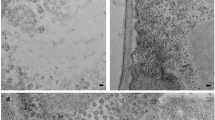Summary
The genomic RNAs of aphid lethal paralysis virus (ALPV) andRhopalosiphum padi virus (RhPV)—two distinct picorna-like viruses found in aphids [Williamson et al. (1988) J Gen Virol 69: 787–795]—were both efficiently translated in rabbit reticulocyte lysates. ALPV RNA was translated into primary products with molecular weights ranging from 92 kDa to 170 kDa. These underwent time-dependent post-translational cleavage to produce smaller polypeptides including some with molecular weights comparable to those of the viral structural proteins. A 92 kDa polypeptide as well as smaller proteins were immunoprecipitated with capsid protein antisera, indicating the presence of at least one large capsid subunit protein precursor. RhPV RNA was translated into products of molecular weights ranging from 45 kDa to 175 kDa. There was no evidence for time-dependent post-translation cleavage of RhPV translation products. However, a 60 kDa polypeptide was precipitated with antiserum to RhPV virions, indicating that at least one capsid protein of RhPV is derived by proteolysis of a precursor protein, like those of ALPV and most other picornaviruses.
Similar content being viewed by others
References
Arnold E, Luo M, Vriend G, Rossmann MG, Palmenberg AC, Parks GD, Nicklin MJH, Wimmer E (1987) Implications of the picornavirus capsid structure for polyprotein processing. Proc Natl Acad Sci USA 84: 21–25
Brisco MJ, Hull R, Wilson TMA (1985) The effect of extraction protocol on the yield, purity, and translation products of RNA from an isometric plant virus. J Virol Methods 10: 195–202
Dorner AJ, Semler BL, Jackson RJ, Hanecak R, Duprey E, Wimmer E (1984) In vitro translation of poliovirus RNA: utilization of internal initiation sites in reticulocyte lysate. J Virol 50: 507–514
Fenner F (1976) Classification and nomenclature of viruses. Second report of the International Committee on Taxonomy of Viruses. Intervirology 7: 39–40
Gupta S, Shih DS, Shih CYT (1985) A comparative study on the translation of cardiovirus RNAs in rabbit reticulocyte lysates. Virology 144: 523–528
Grubman MJ (1984) In vitro morphogenesis of foot-and-mouth disease virus. J Virol 43: 760–765
Harris TJR, Brown F, Sangar DV (1981) Differential precipitation of foot and mouth disease virus proteins made in vivo and in vitro by hyperimmune and virus particle guinea pig antisera. Virology 112: 91–98
Kessler SW (1975) Rapid isolation of antigen from cells with a staphylococcal protein A-antibody adsorbent: parameters of the interaction of antibody-antigen complexes with protein A. J Immunol 155: 1617–1624
Laemmli UK (1970) Cleavage of structural proteins during assembly of the head of bacteriophage T4. Nature 227: 680–685
Moore NF, Reavy B, King L (1985) General characteristics, gene organization and expression of small RNA viruses of insects. J Gen Virol 66: 647–659
Palmenberg AC (1987) Comparative organization and genome structure in picornaviruses. In: Brinton MA, Rueckert RR (eds) Positive strand RNA viruses. Alan R Liss, New York, pp 25–34
Pelham HRB (1979) Synthesis and proteolytic processing of cowpea mosaic virus proteins in reticulocyte lysates. Virology 96: 463–477
Reavy B, Moore NF (1981) In vitro translation of cricket paralysis virus RNA. Arch Virol 67: 175–180
Reavy B, Moore NF (1981) Cell-free translation of cricket paralysis virus RNA: analysis of the synthesis and processing of virus-specified proteins. J Gen Virol 55: 429–438
Reavy B, Moore NF (1983) Cell-free translation ofDrosophila C virus RNA: identification of a virus protease activity involved in capsid protein synthesis and further studies on in vitro processing of cricket paralysis virus specific proteins. Arch Virol 76: 101–115
Reavy B, Moore NF (1983) An inhibitor-resistant protease specified by an insect picornavirus, and the role of cellular proteases in the rapid processing of capsid protein precursors. J Gen Virol 64: 1831–1833
Semler BL, Johnson VH, Dewalt PG, Ypma-Wong MF (1987) Site-specific mutagenesis of cDNA clones expressing a poliovirus proteinase. J Cell Biochem 33: 39–51
Toyoda H, Nicklin MJH, Murray MV, Anderson CW, Dunn JJ, Studier FW, Wimmer E (1986) A second virus-encoded proteinase involved in proteolytic processing of polio virus polyprotein. Cell 45: 761–770
Williamson C, Rybicki EP, Kasdorf GGF, Von Wechmar MB (1988) Characterization of a new picornalike virus isolated from aphids. J Gen Virol 69: 787–795
Williamson C, Von Wechmar MB, Rybicki EP (1989) Further characterization ofRhopalosiphum padi virus of aphids and comparison of isolates from South Africa and Illinois. J Invertebr Pathol 53: 85–96
Author information
Authors and Affiliations
Rights and permissions
About this article
Cite this article
Williamson, C., Rybicki, E.P. A comparative study on the cell-free translation of the genomic RNAs of two aphid picorna-like viruses. Archives of Virology 109, 59–70 (1989). https://doi.org/10.1007/BF01310518
Received:
Accepted:
Issue Date:
DOI: https://doi.org/10.1007/BF01310518




